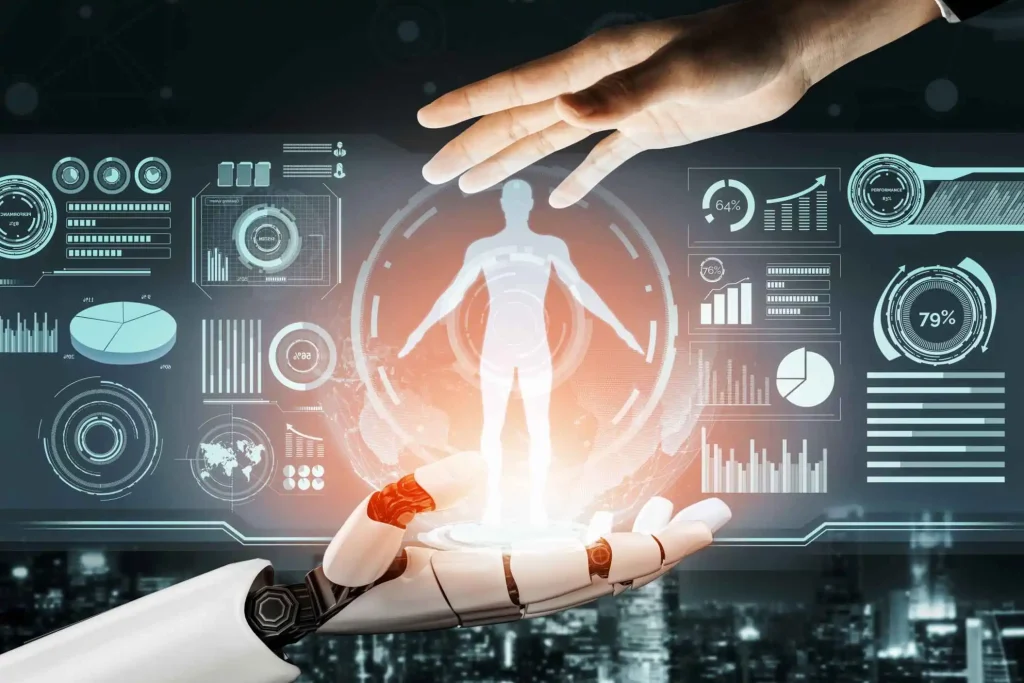Posted by Keyss
Human + Machine: The Rise of Bio-AI Interfaces
A decade ago, merging the human brain with a computer sounded like science fiction.
Today, it’s an emerging reality — and the world is witnessing the birth of Bio-AI Interfaces, where biotechnology and artificial intelligence come together to unlock unprecedented possibilities in health, cognition, and human performance.
From AI-driven diagnostics that detect diseases before symptoms appear, to brain-computer interfaces (BCIs) that let paralyzed individuals communicate through thought, the Human + Machine convergence is redefining what it means to be intelligent, conscious, and alive in the 21st century.
The Rise of Bio-AI: When Biology Meets Code
The term Bio-AI refers to the integration of biological systems and artificial intelligence — using data, sensors, and algorithms to interpret, augment, or even merge with human biology.
Key Developments Driving the Trend:
Brain-Computer Interfaces (BCIs) that connect neural activity directly to digital systems.
AI-based healthcare diagnostics powered by genomic and biomarker data.
Synthetic biology and bioinformatics, where AI designs proteins, drugs, and cellular therapies.
Cognitive enhancement tools that combine wearable neurotech with machine learning.
Together, these technologies signal the dawn of a new era: the programmable human body.
Brain-Computer Interfaces (BCIs): From Thought to Action
BCIs are at the heart of the bio-AI revolution. They translate brain signals into digital commands, enabling seamless communication between neurons and machines.
1. Neuralink and the Frontier of Brain-Machine Fusion
Elon Musk’s Neuralink made headlines by implanting a chip that allowed a human to control a computer cursor using thought alone.
Other companies — like Synchron, Precision Neuroscience, and Blackrock Neurotech — are developing less invasive approaches, focusing on restoring speech, movement, and memory.
These advances promise breakthroughs in treating:
Paralysis and spinal cord injuries.
Parkinson’s disease and epilepsy.
Alzheimer’s-related cognitive decline.
But BCIs also open the door to neural augmentation — enhancing learning speed, attention, and memory beyond natural human limits.
AI Diagnostics: The Algorithmic Doctor
Artificial intelligence is rapidly transforming medicine by turning biological data into actionable intelligence.
How AI Is Changing Healthcare:
Medical Imaging: Deep learning models outperform radiologists in detecting cancers, fractures, and organ anomalies.
Genomic Analysis: AI identifies mutations linked to diseases and predicts drug responses.
Predictive Healthcare: Machine learning algorithms detect early signs of cardiovascular, neurological, or metabolic conditions.
Startups like Tempus, PathAI, and Butterfly Network are merging data science and medicine to create continuous, personalized health monitoring systems — effectively turning healthcare from reactive to proactive.
Neurotech in Everyday Life: Beyond Medicine
Neurotechnology isn’t just about healing — it’s about enhancing.
Consumer Neurotech on the Rise:
Wearable EEG headbands (like Muse and Neurosity) help users manage stress, focus, and sleep.
Cognitive training platforms integrate biosensors and AI to personalize learning.
Haptic and neural feedback systems enable immersive experiences in gaming, AR/VR, and education.
As bio-AI becomes more accessible, we’re entering a world where human-machine integration could extend from clinics to classrooms — and even to your smartphone.
Ethical and Societal Questions
With great innovation comes profound responsibility. The rise of Bio-AI interfaces raises difficult ethical questions:
1. Data Ownership and Privacy
If brain activity or genomic data can be read, who owns it — the individual, the device maker, or the algorithm provider?
Protecting neural data will become as critical as protecting financial or biometric data today.
2. Cognitive Autonomy
If AI systems can influence thoughts, emotions, or decisions, where does human agency end?
The line between augmentation and manipulation must be carefully defined.
3. Accessibility and Inequality
Will neurotech become available to everyone — or just the wealthy few?
Without equitable access, “enhanced humans” could deepen social divides.
4. Regulation and Safety
Bio-AI devices merge medical technology with AI — two heavily regulated domains.
Governments will need new frameworks for ethical, safe, and transparent deployment.
As technology moves faster than policy, ethics will become a crucial differentiator for responsible innovators.
The Science Behind the Merge
At the core of bio-AI interfaces lies data-driven biology — converting complex biological signals into digital information that AI systems can interpret and act upon.
Key Technologies Powering Bio-AI Interfaces:
Neural Decoding: AI models that map brain waves to commands or speech.
Biometric Sensors: Detect electrical, chemical, or optical signals from the body.
Machine Learning Models: Predict behavior, emotion, or disease progression.
Bioinformatics Pipelines: Use AI to process genomic and proteomic data at scale.
In essence, the human body becomes a data ecosystem, with AI acting as the interpreter and amplifier.
The Road Ahead: Toward Symbiotic Intelligence
Researchers envision a future of symbiotic intelligence — where humans and machines collaborate seamlessly.
Possible Futures Include:
AI-powered prosthetics controlled directly by neural intent.
Memory restoration implants for Alzheimer’s patients.
Real-time brain translation allowing silent communication.
Augmented cognition systems enhancing creativity and problem-solving.
As brain interfaces evolve and AI grows more sophisticated, the boundaries between human and machine will blur — not in competition, but in cooperation.
The ultimate goal is not to replace humans with machines, but to augment human potential through intelligent partnership.
What to Watch in 2025 and Beyond
FDA and Global Regulatory Approvals:
More neurotech companies moving from lab to market.AI-Neural Data Fusion:
Better models interpreting complex brain signals in real time.Neural Privacy Standards:
The emergence of “neuro-rights” legislation in the U.S., EU, and Latin America.Consumer Adoption of Cognitive Tech:
Neuro-wearables entering mainstream wellness, education, and productivity markets.
Conclusion: The Dawn of Human-Machine Synergy
The rise of Bio-AI interfaces represents one of the most profound frontiers of innovation — where biology, computation, and consciousness converge.
As humans learn to think with machines, and machines learn to understand us, we’re not witnessing the end of human intelligence — we’re expanding it.
The real challenge ahead isn’t technological — it’s ethical and societal.
How we choose to integrate this power will define the next century of human evolution.
The question is no longer whether humans and machines will merge — it’s how responsibly we make that future happen.

